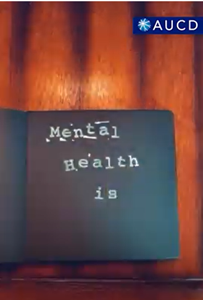Mental Health and Autism Spectrum Disorder
**We use both identity-first (autistic youth) and person-first language (children with autism) when speaking about autistic children. We recognize that this is an important conversation in our field and that preferences for identity first and person-first language differ by individual.**
Video:
Mental Health Is... (Runtime: 2:06)
or click photo to view video
 Children with ASD often experience mental health symptoms that influence their daily lives and functioning across different areas of life.
Children with ASD often experience mental health symptoms that influence their daily lives and functioning across different areas of life.
About 7 in 10 autistic youth also have at least one additional mental health condition.
Parents, caregivers, and providers may have a hard time recognizing and managing the different behaviors and symptoms.
When a child has multiple symptoms or is impacted in multiple areas, it can be difficult to know where the behaviors are coming from. There are a number of reasons why it may be hard to tell if your autistic child is also struggling with a mental health condition.
Some reasons include:
- Mental health symptoms overlap with autism
- Autistic children sometimes have difficulty expressing their feelings/emotions
- Challenging behaviors may mask the mental health condition
- For some autistic youth, cognitive and/or language challenges may make it difficult to understand what is causing or contributing to the behaviors
It may be even harder to tell if your child is experiencing symptoms in addition to autism if they are very young or if they have emerging language. Understanding the possible symptoms and behaviors that are consistent with certain mental health conditions can help guide treatment direction and options.
Some of the most common co-occurring mental health conditions are anxiety, Attention-Deficit/ Hyperactivity Disorder (ADHD), and depression. Parents also often report challenging behaviors and meltdowns.
Below is a list of symptoms and behaviors that we often see in children with ASD. There are many examples that follow; some examples describe very verbal youth while other examples describe children with developing language. The goal of our descriptions
and examples is to try to capture the broad spectrum of autistic youth.

Anxiety
What Could Anxiety Look Like?

Attention Deficit Hyperactivity Disorder (ADHD)
What Could ADHD Look Like?

Depression
What Could Depression Look Like?

Obsessive Compulsive Disorder (OCD)
What Could Obsessive Compulsive Disorder (OCD) Look Like?
The website development was supported by the Children’s Mental Health Champion program, a program formed as part of a cooperative agreement with AUCD and the CDC. For more information see AUCD's National Center on Disability in Public Health. The content was developed by Courtney Paisley and Judy Reaven.
Reference List
American Psychiatric Association. (2013). Diagnostic and statistical manual of mental disorder (5th ed.). Washington, DC: American Psychiatric Association.
Gotham, K., Unruh, K., & Lord, C. (2015). Depression and its measurement in verbal adolescents and adults with autism spectrum disorder. Autism, 19(4), 491-504.
Kerns, C. M., & Kendall, P. C. (2012). The presentation and classification of anxiety in autism spectrum disorder. Clinical Psychology: Science and Practice, 19(4), 323.
Middleton, C.E., Hayutin, L., Reaven, J., 2022. 9.24. Special Populations: Youth With Developmental Disabilities and Co-occurring Mental Health Conditions. In: Asmundson, G.J.G. (Ed.), Comprehensive Clinical Psychology, 2nd edition, vol. 9. Elsevier, pp. 404–427. https://dx.doi.org/10.1016/B978-0-12-818697-8.00163-1
Reaven, J. (2011). The treatment of anxiety symptoms in youth with high-functioning autism spectrum disorders: Developmental considerations for parents. Brain research, 1380, 255-263.
Reaven, J., & Hepburn, S. (2003). Cognitive-behavioral treatment of obsessive-compulsive disorder in a child with Asperger syndrome: A case report. Autism, 7(2), 145-164.
Russell, A. J., Mataix-Cols, D., Anson, M., & Murphy, D. G. (2005). Obsessions and compulsions in Asperger syndrome and high-functioning autism. The British Journal of Psychiatry, 186(6), 525-528.
Strang, J. F., Powers, M. D., Knauss, M., Sibarium, E., Leibowitz, S. F., Kenworthy, L., ... & Anthony, L. G. (2018). “They thought it was an obsession”: Trajectories and perspectives of autistic transgender and gender-diverse adolescents. Journal of autism and developmental disorders, 48(12), 4039-4055.
Strang, J. F., van der Miesen, A. I., Caplan, R., Hughes, C., daVanport, S., & Lai, M. C. (2020). Both sex-and gender-related factors should be considered in autism research and clinical practice. Autism, 24(3), 539-543.
Strauss, P., Cook, A., Watson, V., Winter, S., Whitehouse, A., Albrecht, N., ... & Lin, A. (2021). Mental health difficulties among trans and gender diverse young people with an autism spectrum disorder (ASD): Findings from Trans Pathways. Journal of Psychiatric Research, 137, 360-367.
White, S. W., Oswald, D., Ollendick, T., & Scahill, L. (2009). Anxiety in children and adolescents with autism spectrum disorders. Clinical psychology review, 29(3), 216-229.